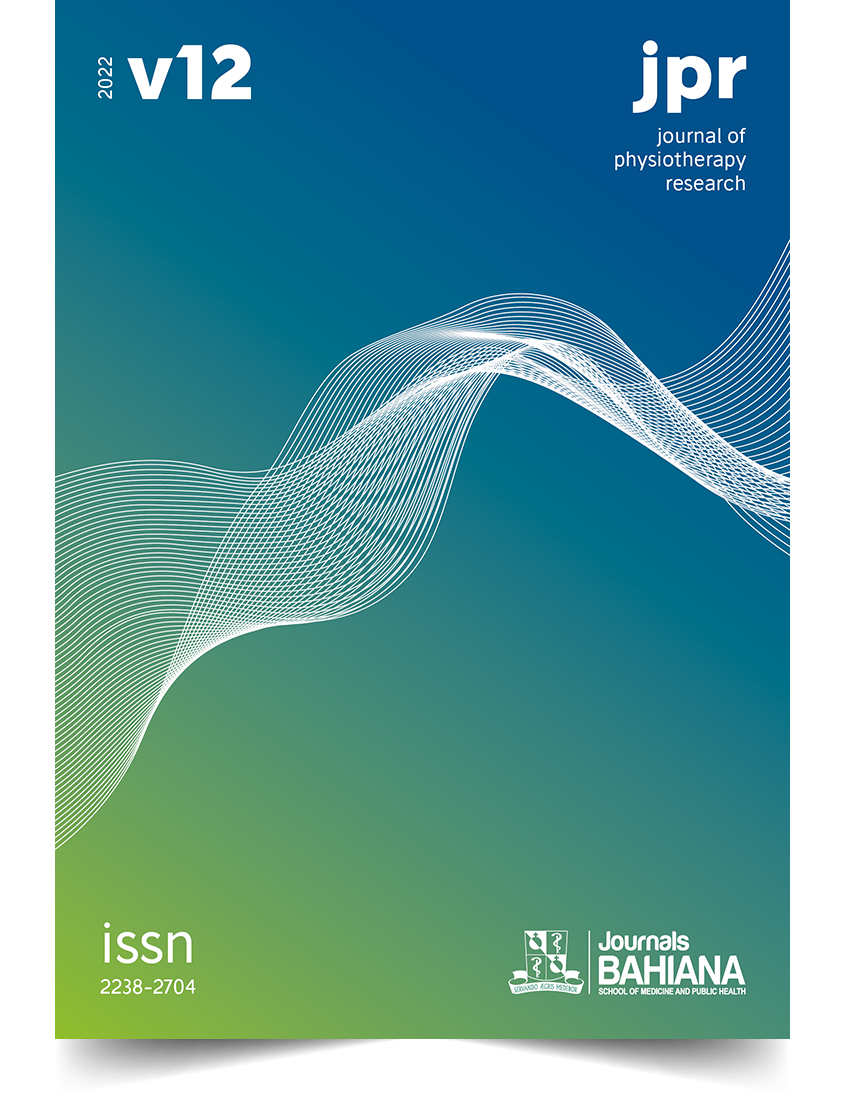The effects of global active stretching on classic ballet dancers
DOI:
https://doi.org/10.17267/2238-2704rpf.2022.e4396Keywords:
Dancing, Muscle Stretching Exercises, Physical TherapyAbstract
INTRODUCTION: Global Active Stretching (GAS) can be a good strategy for improving posture and quality of life and reducing pain. It acts with stretching of muscle chains and can provide improvement of ballet practice without major physical stresses. OBJECTIVE: To verify the effects of GAS on the posture, pain and quality of life of classic ballet dancers. MATERIALS AND METHODS: It was a randomized clinical trial from November 2020 to October 2021. It consists of 20 dancers (aged between 12 and 22 years), without orthopedic or recovering lesions, and without physical therapy treatment. These are divided into two groups. The control group in which there was no intervention and the SGA group, which performed three postures during 15 minutes for each, twice a week, totaling 10 sessions. The Athlete's Quality of Life Questionnaire, The Nordic Musculoskeletal Questionnaire and the Postural Assessment Software were evaluated using the t tests (independence), the t test (paired), the G test (contingency) and the Chi-square. RESULTS: There was no statistical difference in quality of life and pain, but in the control group there was an increase in body extension (0.003) and ankle dorsiflexion (0.01); and in the SGA group, increased left knee vaver (0.05), reduction of internal rotation of the femoral head (0.01) and extension of the left knee. CONCLUSION: There were effects of SGA only on the posture of the dancers, a fact not found in their pain and quality of life. Brazilian Registry of Clinical Trials (ReBEC) protocol RBR-10wckkk7.
Downloads
References
Anjos KSS, Oliveira RC, Velardi M. The construction of the ideal body in classical ballet: a phenomenological investigation. Revis Brasil de Educ Fís e Esp. 2015;29(3):439-452. https://doi.org/10.1590/1807-55092015000300439
Costa C, Teixeira Z. The experience of pain among classical dance ballerinas: meanings derived from a qualitative study. Ciênc, saúde colet. 2019;24(5):1657-1667. https://doi.org/10.1590/1413-81232018245.04302019
Silva AMB, Emuno SRF. Pain and injury in adolescent dancers: systematic review. Rev Dor. 2016;17(2);132-135. https://doi.org/10.5935/1806-0013.20160030
Ribeiro JN, Moura UIS, Mendes LR, Antonelli BA, Schwingel PA, Angelo RCO. Postural profile of classical ballerinas from the Vale do São Francisco - Region of Brazil. Coluna/Columna. 2016;15(3):199-204. https://doi.org/10.1590/S1808-185120161503155900
Lima MA. Treino pliométrico para crianças e adolescentes [trabalho de conclusão de curso]. Santos: Universidade Católica de Santos; 2011.
Ackland TR, Elliot BC, Bloomfield J. Anatomia e biomecânica aplicadas no esporte. Barueri: Manole; 2011.
Souchard P. Autoposturas da RPG: O método do Stretching Global Ativo (SGA). São Paulo: Summus Editorial; 2019.
Grau N. SGA: A serviço do esporte. São Paulo: É realizações; 2003.
Oliveira AL, Nogueira N. Influência do Stretching Global Activo na flexibilidade da Cadeia Posterior e no Salto Vertical no Voleibol. Revista Portuguesa de Fisioterapia no Desporto [Internet]. 2008;1(2):7-17. Available from: https://www.academia.edu/7353396/Influ%C3%AAncia_do_Stretching_Global_Activo_na_Flexibilidade_da_Cadeia_Posterior_e_no_Salto_Vertical_no_Voleibol
Cunha RA. Elaboração e validação do questionário sobre qualidade de vida de atletas (QQVA) [dissertação] [Internet]. Belo Horizonte: Universidade Federal de Minas Gerais; 2008. Available from: https://repositorio.ufmg.br/handle/1843/KMCG-7NRM33
Mesquita CC, Ribeiro JC, Moreira P. Portuguese version of the standardized Nordic Musculoskeletal questionnaire: cross cultural and reliability. J Public Health. 2010;18(5):461-466. https://doi.org/10.1007/s10389-010-0331-0
Duarte M, Ferreira EA, Maldonado EP, Freitas AZ. Documentação sobre o SAPO – Software para avaliação postural [Internet]; 2005. Available from: https://pesquisa.ufabc.edu.br/bmclab/sapo2/SAPOdoc.pdf
Silva AMB, Enumo SRF, Afonso RM, Araújo MF, Luz TSR, Carvalho LF, et al. Survey on Quality of Life of Athletes: Adaptation and Validity Evidences for Dancers. Av En Psicol Latinoam. 2019;37(1):121-131. https://doi.org/10.12804/revistas.urosario.edu.co/apl/a.4575
Ribeiro ISCT, Finotelli Junior I. Associação entre qualidade de vida do atleta com sintomas de ansiedade e ansiedade pré-competitiva. 15º Congresso Brasileiro e 7º Congresso Internacional de Psicologia do Esporte e do Exercício [Internet]. Anais do XV Congresso Brasileiro e VII Congresso Internacional de Psicologia do Esporte e do Exercício [Internet]. Florianópolis; 2013. Disponível em: https://www.cesusc.edu.br/1746-congresso-internacional-de-psicologia-do-esporte-e-do-exercicio-comeca-na-quarta/
Dantas SV, Neves ISF, Mota DM, Marques COM, Sousa FAN, Leal SS. Evaluation of postural changes of badminton athletes submitted to Global Active Stretching. ConScien Saúde. 2014;13(2):211-217. https://doi.org/10.5585/conssaude.v13n2.4745
Ferreira EAG. Postura e controle postural: desenvolvimento e aplicação de método quantitativo de avaliação postural [tese] [Internet]. São Paulo: Universidade de São Paulo; 2005. Available from: https://www.teses.usp.br/teses/disponiveis/5/5160/tde-20092006-142252/pt-br.php
Salles TA. O balé clássico: principais lesões e um trabalho preventivo baseado na preparação física [monografia]. Campinas: Universidade Estadual de Campinas; 2008.
Cardoso AA, Reis NM, Marinho APR, Vieira MCS, Boing L, Guimarães ACA. Injuries in professional dancers: a systematic review. Rev Bras Med Esporte. 2017;23(6):504-509. https://doi.org/10.1590/1517-869220172306170788
Meereis ECW, Teixeira CS, Pranke GI, Lemos LFC, Mot ACB. Sintomatologia dolorosa em bailarinos: uma revisa?o. Rev bras. ciênc. mov. [Internet]. 2013; 21(2):143-150. Available from: https://portalrevistas.ucb.br/index.php/rbcm/article/view/3078
Carvalho RSG. Alterações posturais em bailarinas clássicas da escola livre de dança de Santos/SP [monografia]. Santos: Universidade Federal de São Paulo; 2019.
Schweich LC, Gimelli AM, Elosta MB, Matos WSW, Martinez PF, Oliveira Júnior AS. Epidemiology of athletic injuries in classic ballet practitioners. Fisioter, Pesq, 2014;21(4):353-358. https://doi.org/10.590/1809-2950/12833321042014
Garcia PU, Aranda MC. Analytical stretching and active global stretching in physical education classes. Fisiot. 2011;33(2):70-8. https://doi.org/10.1016/j.ft.2011.02.003
Silvestri BN, Polizelli AB. Implantação de um programa de stretching global ativo nas atletas de futsal feminino da UNESC. Rev Inic Cientif [Internet]. 2010;8(1):136-148. Available from: https://periodicos.unesc.net/ojs/index.php/iniciacaocientifica/article/view/1586
Fernandes SN, Fernandes O, Loss J, Cruz-Ferreira A. O efeito do método pilates na prevenção de lesões em bailarinos profissionais. Rev de Cienc del dep [Internet]. 2015:11(1); 53-69. Available from: https://e-balonmano.com/ojs/index.php/revista/article/view/199
Downloads
Published
Issue
Section
License
Copyright (c) 2022 Ana Letícia Cardoso Pinto, Cristiane de Fátima Pimenta da Costa, Paula Luiza Matni dos Santos, Andréa de Cassia Lima Guimarães, Maria Lucia Ribeiro de Azeredo, Renata Amanajás de Melo, Biatriz Araújo Cardoso Dias, George Alberto da Silva Dias

This work is licensed under a Creative Commons Attribution 4.0 International License.
This work is licensed under a Creative Commons Attribution 4.0 International License.



